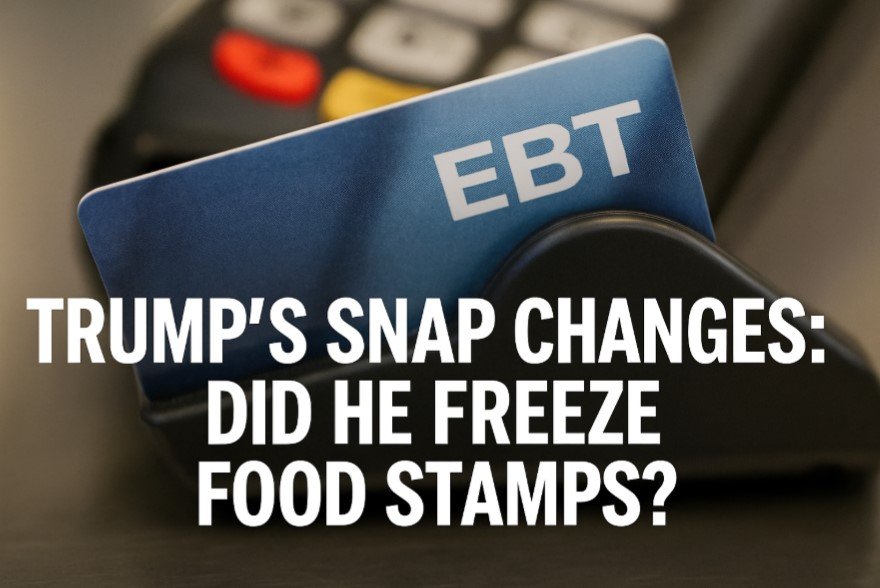News
Trump’s SNAP Changes: Did He Freeze Food Stamps?

The Supplemental Nutrition Assistance Program (SNAP), also known as food stamps, is one of the largest food assistance programs in the United States. It helps millions of low-income families buy food. Over the years, the program has gone through many changes under different presidential administrations. One question many people have is: Did former President Donald Trump freeze food stamps?
In this article, we explain what happened to SNAP during the Trump administration. We look at the changes made, who was affected, and whether the program was frozen.
What is SNAP?
SNAP is a government program that provides money for food to people who need it. The money is loaded onto an electronic benefits card, and people can use it at grocery stores, supermarkets, and farmers’ markets. The goal of SNAP is to reduce hunger and support nutrition for families with low incomes.
What Does “Freezing Food Stamps” Mean?
When people ask if Trump “froze” food stamps, they usually mean whether he stopped new people from signing up or blocked benefits from being distributed. A “freeze” could also mean cutting off access to the program for certain groups or making rules that make it harder to qualify.
Did Trump Freeze SNAP Benefits?
No, the Trump administration did not completely freeze food stamps. However, there were several policy changes that made it more difficult for some people to qualify. These changes mostly focused on work requirements and eligibility rules. So while benefits were not stopped entirely, access was reduced for some people.
What Changes Did Trump Make?
Work Requirements for Able-Bodied Adults Without Dependents (ABAWDs):
One of the main changes the Trump administration tried to make was related to work rules for adults without children. These people were already required to work at least 20 hours per week to receive food stamps for more than three months in a three-year period. However, states had the option to waive these rules in areas with high unemployment.
The Trump administration wanted to limit the states’ ability to offer waivers. The goal was to push more people to find work. This would have resulted in about 700,000 people losing access to SNAP benefits. However, the rule was blocked by a federal judge and never went fully into effect.
Tightening Eligibility Rules:
The administration also tried to stop “broad-based categorical eligibility.” This policy allowed people who receive other forms of government help (like Temporary Assistance for Needy Families) to automatically qualify for SNAP.
The proposed change would have made it harder for many families to get food stamps, especially those with slightly higher incomes or modest savings. This rule was also blocked and did not go into effect.
Changes to Utility Deductions:
Another rule aimed to change how utility costs are calculated when determining SNAP benefits. Utility costs can lower the amount of income counted when applying for SNAP. The Trump administration wanted to standardize this across states, which could have led to smaller benefit amounts for some people. This rule also faced pushback but was eventually finalized late in Trump’s term.
Impact of the Proposed Changes
While none of the major changes went fully into effect during Trump’s presidency, the proposals caused concern among advocacy groups and SNAP recipients. If the rules had been implemented, they could have affected millions of people by reducing benefits or disqualifying them entirely.
The rules mainly targeted single adults without children and people who were considered to have no disabilities. Critics said the changes would increase hunger, especially during economic downturns. Supporters of the rules argued that they would encourage work and reduce dependency on government programs.
COVID-19 and SNAP
When the COVID-19 pandemic began in early 2020, the Trump administration approved emergency changes to SNAP. These changes included allowing states to provide additional food stamp benefits and waiving some work requirements. This shows that although there were efforts to restrict access to SNAP earlier, the administration later supported temporary expansion during the crisis.
These emergency benefits helped many families during job losses and school closures. The Biden administration later extended many of these pandemic-related changes.
Conclusion
To answer the question simply: No, Trump did not freeze food stamps completely. However, his administration did try to make changes that would have made it harder for certain people to qualify for SNAP. Most of the proposed rules were blocked by courts or not finalized.
The idea of freezing food stamps is often misunderstood. While benefits continued to be delivered, the administration’s efforts focused on tightening eligibility and reducing the number of people on the program.
Understanding SNAP policies is important because they directly affect the health and well-being of millions of people. Any proposed change can have a large impact on families across the country.
If you’re worried about changes to SNAP or need help applying, it’s best to contact your local SNAP office or visit official government websites for accurate and updated information.
-

 Lifestyle2 months ago
Lifestyle2 months agoKehinde Alli: Empowering Youth Through the Alli Foundation
-

 News2 months ago
News2 months agoIryna Zarutska: Refugee Journey Cut Short by Violence
-

 Business2 months ago
Business2 months agoTech Capital One: Careers, Jobs, and Opportunities
-

 Digital Marketing2 months ago
Digital Marketing2 months agoHow Embedded Payments Are Turning Apps Into Revenue Engines






